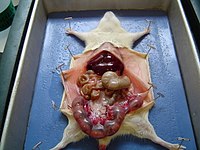Dissection: Difference between revisions
nice pic, it even says Taulant23 right at the center. |
thumb|200px|left|Dissected rat showing the [[heart.]] Taking my username on the picture. |
||
| Line 11: | Line 11: | ||
High school students stereotypically dissect frogs or [[fetal pigs]] in science class, but the trend in the [[U.S.]] is towards allowing students to opt out of dissection activities or perform dissections electronically on the computer, with programs capable of performing virtual dissections on a variety of animals. |
High school students stereotypically dissect frogs or [[fetal pigs]] in science class, but the trend in the [[U.S.]] is towards allowing students to opt out of dissection activities or perform dissections electronically on the computer, with programs capable of performing virtual dissections on a variety of animals. |
||
[[Image:Ratheart.jpg|thumb|200px|left|Dissected rat showing the [[heart]].]] |
|||
==History== |
==History== |
||
Early systematic human dissections were carried out by the Greek physicians [[Herophilos|Herophilus of Chalcedon]] and [[Erasistratus of Chios]] in the early part of the third century BC.<ref>http://www.ncbi.nlm.nih.gov/pubmed/1285450</ref>Before and after this time investigators appeared to largely limit themselves to non human animals. |
Early systematic human dissections were carried out by the Greek physicians [[Herophilos|Herophilus of Chalcedon]] and [[Erasistratus of Chios]] in the early part of the third century BC.<ref>http://www.ncbi.nlm.nih.gov/pubmed/1285450</ref>Before and after this time investigators appeared to largely limit themselves to non human animals. |
||
Revision as of 23:00, 29 February 2008

Dissection is usually the process of disassembling and observing something to determine its internal structure and as an aid to discerning the function and relationships of its components. It may refer also to some spontaneous natural process of disassembly as in aortic dissection.
In biology
Dissection is usually applied to the examination of plants and animals. The term is also used in relation to mechanisms, computer programs, written materials, etc., as a synonym for terms such as reverse engineering or literary deconstruction. Dissection is usually performed by students in courses of biology, botany and anatomy and in association with medical and arts studies.
Vivisection refers to the dissection of a living animal, often for the purposes of physiological investigation. However, in modern parlance the term is often used to refer to any type of experimentation in which animals are injured, with or without actual dissection.
Dissection is often performed as a part of determining a cause of death in autopsy (on humans) and necropsy (on animals) and is an intrinsic part of forensic medicine, such as would be practiced by a coroner.
High school students stereotypically dissect frogs or fetal pigs in science class, but the trend in the U.S. is towards allowing students to opt out of dissection activities or perform dissections electronically on the computer, with programs capable of performing virtual dissections on a variety of animals.
History
Early systematic human dissections were carried out by the Greek physicians Herophilus of Chalcedon and Erasistratus of Chios in the early part of the third century BC.[1]Before and after this time investigators appeared to largely limit themselves to non human animals.
Latter human dissections were conducted by the Arabian physician Ibn Zuhr (Avenzoar) (1091-1161) in al-Andalus,[2] followed by several other Arabian physicians: Saladin's physician Ibn Jumay in the 12th century, Abd-el-latif in Egypt circa 1200,[3] and Ibn al-Nafis in Syria circa 1242.[4][5]
The first public human dissection was conducted by Ján Jesenský (1566-1621), the Slovak physician, surgeon, anatomist and the rector of a Charles University in Prague in 1600.
Tools used
The following are tools commonly used in biological dissection.
- Scalpel
- Scissors
- Thumb Forceps or Fine point splinter
- Mall probe and seeker
- Surgical Spatula
- Magnifying glass
- Chain & Hooks (surgical)
- Razor
- Blow Pipe (surgical)
- Prong (surgical)
- Teasing needles
- Pipet or Medicine dropper
- Ruler or caliper
- T pins
References
- ^ http://www.ncbi.nlm.nih.gov/pubmed/1285450
- ^ Islamic medicine, Hutchinson Encyclopedia.
- ^ Emilie Savage-Smith (1996), "Medicine", in Roshdi Rashed, ed., Encyclopedia of the History of Arabic Science, Vol. 3, p. 903-962 [951-952]. Routledge, London and New York.
- ^ S. A. Al-Dabbagh (1978). "Ibn Al-Nafis and the pulmonary circulation", The Lancet 1, p. 1148.
- ^ Chairman's Reflections (2004), "Traditional Medicine Among Gulf Arabs, Part II: Blood-letting", Heart Views 5 (2), p. 74-85 [80].
